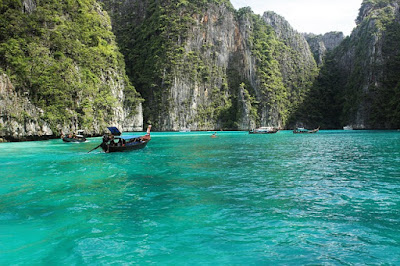Bangkok
Bangkok is the capital and most populous city Thailand. It is known in Thai as Krung Thep Maha Nakhon or simply Krung Thep. The city occupies 1,568.7 square kilometres (605.7 sq mi) in the Chao Phraya River delta in central Thailand and has an estimated population of 10,539 million as of 2020, 15.3 percent of the country's population. Over fourtenn million people (22.2 percent) live within the surrounding Bangkok Metropolitan Region at the 2010 census, making Bangkok an extreme primate city, dwarfing Thailand's other urban centres in both size and importance to national economy.
Bangkok traces its roots to a small trading post during the Ayutthaya kingdom in the 15th century, which eventually grew and became the site of two capital cities. Thonburi in 1768 and Rattanakosin in 1782. Bangkok was at the heart of the modernization of Siam, later rename to Thailand, during the late-19th century, as the century faced pressures from the West, The city was at the centre of Thailand 's political struggles throughout the 20th century, as the century abolished absolute monarchy, adopted constitutional rule, and underwent numerous cups and several uprisings. The city grew rapidly during the 1960s through the 1980s and now experts a significant impact on Thailand's politics, economy, education, media and modern society.
The Asian investment boom in the 1980s and 1990s led many multinational corporations to locate their regional headquarters in Bangkok. The city is now a regional force in finance and business. It is an international hub for transport and health care, and has emerged as centre for arts, fashion, and entertainment. The city is know for street life and cultural landmarks, as well as its red-light districts. The Grand Palace and Buddhist temples including Wat Arun and Wat Pho stand in contrast with other tourist attractions such as the nightlife scenes of Khaosan Road and Patpong, Bangkok is among the world's top tourist destinations and has been named the world's most visited city consistently in several international rankings.
Bangkok's rapid growth coupled with little urban planning has resulted in a haphazard cityscape and inadequate infrastructure. An inadequate road network, despite and extensive expressway network, together with substantial private car usage, have led to chronic and crippling traffic congestion, which caused severe air pollution in the 1990s. The city has since turned to public transport in an attempt to solve the problem. Five rapid transit lines are now in operation. with more systems under construction or planned by the national government and Bangkok Metropolitan Administration, but congestion still remains a prevalent issue.
History
The history of Bangkok dates at least back to the early 15th century, when it was a village on the west bank of the Chao Phraya River, under the rule of Ayutthaya, Because of its strategic location near the mouth of the river, the town gradually increased in importance. Bangkok initially served a customs outpost with forts on both sides of the river, and was the site of siege in 1688 in which the French were expelled from Siam. After the fall of Ayutthaya to the Burmese Empire in 1767, the newly crowned King Taksin established has capital at the town, which became the base of the Thonburi Kingdom, In 1782, King Phutthayotfa Chulalok (Rama I) succeeded Taksin, move the capital to the eastern bank's Rattanakosin Island, thus founding the Rattanakosin Kingdom. The City Pillar was crected on 21 Aprill 1782, which is regarded as the date of foundation of the present city.
Bangkok's economy gradually expanded through international trade, first with China, then with Western merchants returning in the early-to-mid 19th century. As the capital, Bangkok was the centre of Siam's modernization as it faced pressure form Western powers in the late-19th century. The reigns of King Mongkut (Rama IV, 1851-1868) and Chulalongkorn (Rama V, 1868-1910) saw the introduction of the steam engine, printing press, rail transport and utilities infrastructure in the city,as well as formal education and healthcare. Bangkok became the centre stage for power struggles between the military and political elite as the country abolished absolute monarchy in 1932.
As Thailand allied with Japan in World War II, Bangkok was subject to Allied bombing, but rapidly grew in the post-war period as a result of US aid and government-sponsored investment. Bangkok's role as a US military R&R destination boosted its tourism industry. Disproportionate urban develop led to increasing income inequalities and migration from rural area into Bangkok, its population surged from 1.8 million to 3 million in 1960.
Credit Photo: posttoday.com
Administration of the city was first formalized by King Chulalongkorn in 1906, with the establishment of Monthon Krung Thep Phra Maha Nakhon (มณฑลกรุงเทพพระมหานคร) as a national subdivision. In 1945, the monthon was split into several provinces, the administrative boundaries of which have since further changed. The city in its current from was created in 1972 with the formation of the Bangkok Metropolitan Administration (BMA), following the merger of Phra Nakhon Province on the eastern bank of the Chao Phraya River and Thonburi Province on the west during the previous year.













